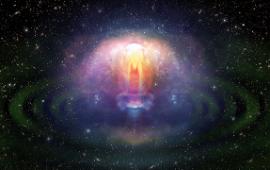Neutron star merger launched superfast ‘jet’ of materials

In Summary
- Radio observations trace ‘jet’ of particles from neutron star merger, known as GW170817, moving at almost the speed of light
- Aftermath of the violent collision observed worldwide by telescopes across the electromagnetic spectrum
- Detection of a fast-moving jet in GW170817 reinforces connection between neutron star mergers and short-duration gamma-ray bursts
Precise tracking of the radio glow generated by the merger of a pair of neutron stars in a distant galaxy has shown that the cataclysmic event launched a narrow jet of particles moving at almost the speed of light.
This finding strengthens the connection between neutron star mergers and the phenomenal explosions known as gamma-ray bursts.
The neutron star merger, known as GW170817, occurred 130 million light-years from Earth and sent a burst of both gravitational and electromagnetic waves rippling through space that reached the Earth one year ago.
In the aftermath of the violent collision, GW170817 was observed worldwide by telescopes across the electromagnetic spectrum.
Interaction with surroundings
By tracking changes in the optical, radio, and X-ray emission of the afterglow, scientists including Swinburne's Dr Adam Deller, from the OzGrav ARC Centre of Excellence for Gravitational Wave Discovery, were able to study how the material flung out during the merger interacted with its surroundings.
Months after the merger one crucial question remained: had the colliding neutron stars launched a powerful, narrow ‘jet’ of very fast moving material that was able to punch clear of the rest of the merger debris? Such jets are required in order to produce the type of gamma-ray bursts that had been predicted theoretically to accompany the merger of neutron stars.
The answer came when an international team tapped the collective might of three separate radio facilities - the Very Long Baseline Array (VLBA), the Karl G Jansky Very Large Array (VLA), and the Robert C Byrd Green Bank Telescope (GBT). The result was the sharpest ever images of the radio afterglow. Over the course of 150 days, the position of the radio emission shifted at a rate that appeared to exceed light speed!
"We measured an apparent motion that is four times faster than light,” says Dr Kunal Mooley of the National Radio Astronomy Observatory and Caltech.
“That illusion, called superluminal motion, results when the jet is pointed nearly toward Earth and the material in the jet is moving close to the speed of light.”
Dr Deller says: "Based on our analysis, this jet most likely is very narrow, at most five degrees wide, and was pointed only 20 degrees away from the Earth's direction. To give this apparently 'superluminal' sideways motion, the material in the jet also has to be blasting outwards at over 97 per cent of the speed of light."
The scenario that emerged is that the initial merger of the two superdense neutron stars caused an explosion that propelled a spherical shell of debris outward. The neutron stars collapsed into a black hole whose powerful gravity began pulling material toward it. That material formed a rapidly-spinning disk that generated a pair of
jets moving outward from its poles.
Observational data indicated that a jet had interacted with the debris, forming a broad ‘cocoon’ of material expanding outward. Before the high-resolution radio images were made, however, it was not clear whether the observed radio emission came from this slow-moving cocoon, or a fast jet that had successfully broken clear.
"Our interpretation is that the cocoon dominated the radio emission until about 60 days after the merger, and at later times the emission was jet-dominated," says Ore Gottlieb, a lead theorist on the study, and PhD candidate at Tel Aviv University.
Connecting star mergers and gamma-ray bursts
The scientists say the detection of a fast-moving jet in GW170817 greatly strengthens the connection between neutron star mergers and short-duration gamma-ray bursts. They add that such narrow jets need to be pointed relatively closely toward the Earth for the gamma ray burst to be detected.
"Our study demonstrates that combining observations from the VLBA, the VLA and the GBT is a powerful means of studying the jets and physics associated with gravitational wave events," Dr Mooley says.
The findings are reported in the 5 September online version of the journal Nature.

